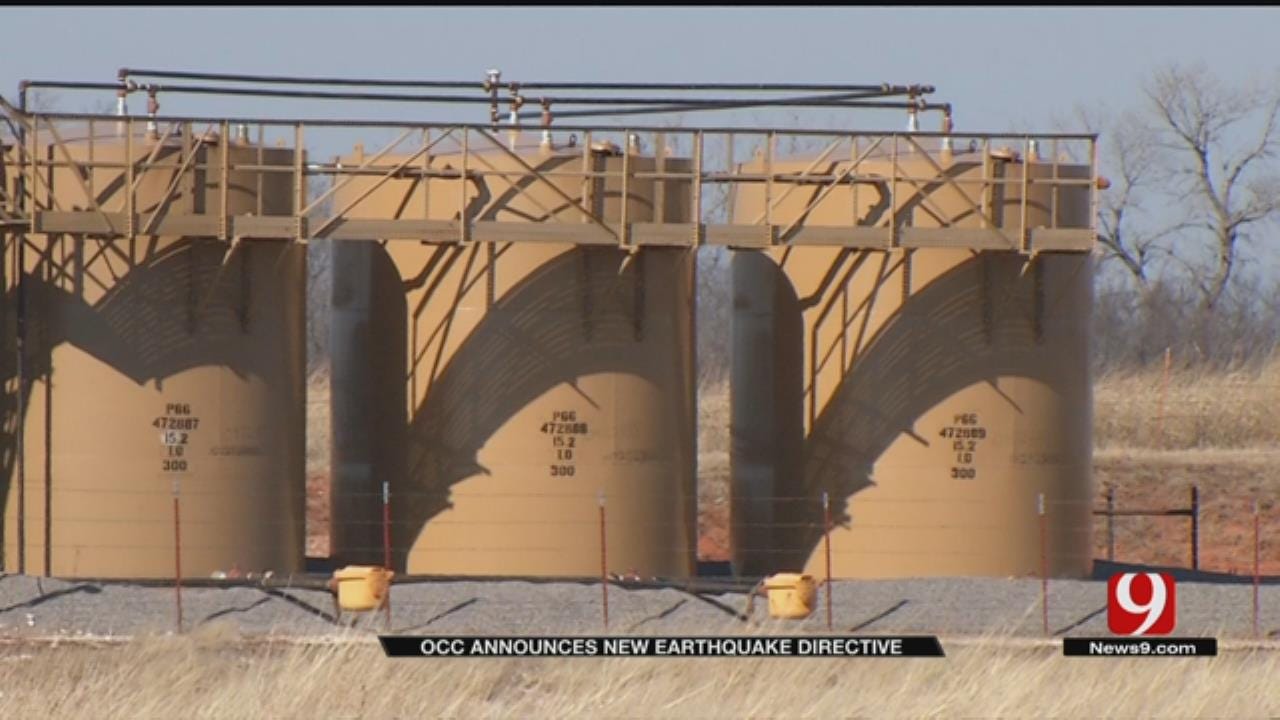Oklahoma Corporation Commission Issues Earthquake Directive
<p>The Oklahoma Corporation Commission has issued a new order limiting future increases in the volume of oil and natural gas wastewater injected into the ground in an effort to reduce the number of earthquakes in the state.</p>Friday, February 24th 2017, 12:18 pm
The Oklahoma Corporation Commission has issued a new order limiting future increases in the volume of oil and natural gas wastewater injected into the ground in an effort to reduce the number of earthquakes in the state.
The commission's Oil and Gas Conservation Division issued the directive Friday for 654 disposal wells in a wide swath of northern Oklahoma.
Division Director Tim Baker said the directive is intended to prevent sudden, sharp increases in disposal volumes. Underground disposal of wastewater has been linked to an increase in earthquakes in Oklahoma in recent years.
Underground disposal of wastewater has been linked to an increase in earthquakes in Oklahoma in recent years. At its peak, seismic activity in Oklahoma produced nearly 1,000 earthquakes in one year. That time period corresponds with the peak of wastewater disposal in the Arbuckle, when companies were injecting nearly 3 million barrels of wastewater a day.
Right now, wells in this area dispose about 1.75 million barrels of wastewater daily. The OCC has taken measured steps to scale back the injections, which has resulted in fewer earthquakes. Now, ahead of projected increases in oil production, they are limiting each well in the area to maintain this trend.
Baker said, “When we first got into this project, we were looking for individual wells that may be causing the problem, and what we’ve learned is it’s not an individual well. It’s the total volume of water going into the Arbuckle.”
Oklahoma Geological Survey data says the number of magnitude 2.7 and stronger earthquakes has dropped from an average of 5.4 per day in 2015 to 3.6 per day last year to 1.4 per day so far in 2017.
“The data from the Oklahoma Geological Survey shows the earthquake rate has been dropping since we issued various directives reducing the then-current volume within the AOI,” OGCD Director Tim Baker said. “The continued drop in earthquakes, as well as new data and input from the Oklahoma Geological Survey have caused a change in our orientation from focusing on current disposal volumes within the AOI to looking ahead to try and ensure there isn’t a sudden, surprise jump in those disposal volumes. This directive includes not only those Arbuckle disposal wells within the AOI already restricted in volume, but also the few potentially high-volume disposal wells that previously were not under a volume reduction directive because there has been no seismicity in their area. In all, it will cover 654 Arbuckle disposal wells in the AOI.”
Baker says the directive will not reduce current volumes, but will keep future volume increases in check.
“We have a few Arbuckle disposal wells in the AOI that without this directive could add more than 2 million barrels a day in disposal to the Arbuckle. They are currently operating at a fraction of their permitted volume, and the new cap will be based on the much lower last 30 day average of their disposal volumes,” Baker said. “Other wells are already operating under a reduction directive with volumes that are lower than even those allowed. We don’t want to see them jump drastically in one day, even if they are within their directive limits. So they will have a cap to limit how much they can increase volume at once.”
Currently, no new wells are being approved in Arbuckle zone, and the OCC is encouraging companies to dispose additional wastewater elsewhere, as well as monitoring the other zones to prevent the same thing from happening there.
The directive also allows operators more flexibility in handling their wastewater.
“We have set up a system under which the operator will have a 30 day allowance, based on the particular directive, for how much he can dispose. Operators will be allowed, on a limited basis, to increase the volumes in certain wells and, if necessary, offset with lower volumes in others, so long as the 30 day allowance that encompasses total disposal of all his wells is not exceeded,” Baker explained. “It is important to note that all directives remain in effect, and all wells currently shut in by directive will remain that way.”
Baker called the directive a “data driven” approach.
“The amount and quality of the data now available to us is far ahead of where we were a year ago,” Baker said. “We can make decisions on a much timelier basis. Given that, operators need to be aware that we will take action if that data indicates further volume reductions should be put in place. The earthquake rate is headed in the right direction, but this remains our most critical issue.”
The Oklahoma Oil and Gas Association is on board with the new limits, but president Chad Warmington hopes the scientists are proven wrong. He said, “What we’re reserving the right to is come back to the commission as we know more in future years about the correlation between disposal and earthquakes and have the ability then to increase volumes if it’s appropriate.”
Scientists now have more seismographs in place in the Arbuckle region to monitor earthquake activity. Baker said the OCC does have other plans to address wastewater disposal if more earthquakes start to occur.
More Like This
February 24th, 2017
April 15th, 2024
April 12th, 2024
March 14th, 2024
Top Headlines
April 23rd, 2024












